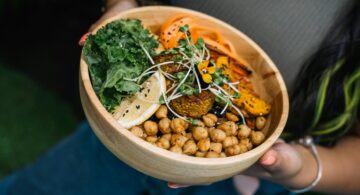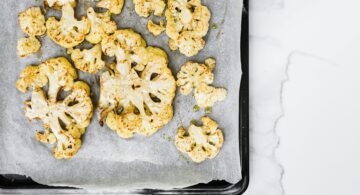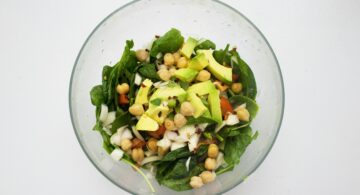Overcoming Crohn’s With Nature’s Foods
I remember when I first heard, or rather saw, Crohn’s disease. I opened up a book titled Patient, Health Thyself. Inside was this before and after photo of a man who had cured his Crohn’s disease with natural foods and supplements.
This man’s name is Jordan Rubin and he has since become a pioneer in natural health industry. He is the author of The Maker’s Diet and the founder and CEO of the company Garden of Life, well-known for its quality supplement and nutrition products. Reading Jordan’s story that day inspired and encouraged me to continue on the path of natural health I had just begun to pursue. He is a living testimony that something as devastating as Crohn’s disease can be cured… 100% naturally.If you or someone you know has been diagnosed with Crohn’s, then it’s more than likely you have given up hope. Your doctor probably informed you about different medications that can help with symptoms, but was also quick to tell you that there is no cure for Crohn’s disease.
But, I am here to tell you different.
Just look at the picture! Jordan was wasting away and his Crohn’s was so severe he had been given a death sentence! He is now healthy and symptom free! You can be, as well!
Healing Your Gut
Crohn’s, like so many other autoimmune diseases, has no definite cause. Many things can trigger Crohn’s, such as stress or even a bacteria imbalance in the gut, which then manifests in inflammation. Inflammation is a natural immune response. However, in the case of Crohn’s disease, the immune system perceives normal cells of the digestive tract as foreign invaders. The side-effects of this attack on normal cells include:- Chronic diarrhea
- Abdominal pain
- Bloody stools
- Ulcers
- Skin disorders
- Anemia (from blood loss)
- Anorexia (extreme weight loss and loss of appetite)
Crohn’s can be quite the double-edged sword. It can not only be brought on by imbalance in the intestinal tract, but its chronic nature only aggravates the imbalance, causing more and more damage. Luckily, there are ways to stop this vicious cycle.
Crohn’s disease can only be overcome by healing the gut. To do this, you must create an environment that is conducive for healing. You wouldn’t expect an insomniac to rest if you’re playing heavy metal music non-stop. Environment is EVERYTHING! If you give your gut the environment it needs to rest and heal, then it will do just that!
Creating a healing environment for Crohn’s involves 2 steps:
1. Eliminating Inflammatory Foods
When your body doesn’t recognize something as food, it is likely to promote an immune reaction and, therefore, inflammation is the result. I’m sure I’ve said it a million times,..
“If you can’t pronounce an ingredient, then don’t eat it!”
If you have no idea what an ingredient is, then it’s likely not real food and your body will indeed notice! Creating a healthy environment in your gut involves real foods, real ingredients, and nothing artificial or made in a lab.
Foods can be characterized by their ability to either promote inflammation or quell it. Although everyone’s body responds differently to different foods, there are universal foods that lend themselves towards inflammation. Some of the worst culprits of digestive tract inflammation include:
- Processed and prepackaged foods
- Fast food
- Artificial anything (colors, sweeteners, or flavors)
- Wheat and more specifically gluten
- Unfermented milk products
Wheat may not sound like such a bad guy, especially when whole-wheat foods have been promoted as healthy. However, 55% of those with Crohn’s disease have also been found to have Celiac disease. An even greater percentage of those with Crohn’s are gluten intolerant. It is quite rare to find someone with an inflammatory bowel disease that tolerates wheat products.
Milk products are amongst the most untolerated, as well. This is primarily caused by milk sugar, otherwise known as lactose. Many people don’t have the necessary enzymes to break down lactose and this can cause major digestive distress. However, fermented milk products like kefir and yogurt have pre-digested lactose. These are much more tolerable and can also be a great way to incorporate beneficial bacteria back into the gut.
Now that you know what not to eat, you probably want to know what you can eat! That brings me to the second step in eliminating Crohn’s disease.
2. Consuming Gut Loving Foods
There is a diet plan specifically designed to heal the gut called the GAPS diet. Although I cannot cover all the specifics in this article, I highly encourage you to research it further. You can read one other article I wrote about the GAPS diet HERE.
I have seen many people heal from Crohn’s disease following the GAPS principles. The consumption of gut loving foods to restore your digestive tract is an essential part of the GAPS diet. So what exactly is a gut loving food? These are foods that:
- Promote a healthy environment in the digestive tract with beneficial bacteria.
- Are easy to digest and do not cause your body distress.
Raw foods, though highly nutritious, can be difficult for those with Crohn’s to digest. It is best to lightly steam your veggies before consuming them. Eventually, as your gut heals, you may be able to incorporate raw foods back into your diet. Until that point, juicing raw fruits and vegetables is a fantastic way to consume nutrients from raw foods without the digestive issues.
Fermented foods are one of the best things you can consume for any kind of digestive problem. They contain bacteria and enzymes that support a balanced digestive tract and fight off toxic microbes. Many of these foods fight inflammation and soothe an angry gut. Some of the best sources of fermented foods include:
- Unsweetened yogurt of kefir
- Sauerkraut (no vinegar added)
- Kombucha
- Water Kefir
Pickles made by fermentation are one of my favorite sources of beneficial bacteria for the gut. A company called Bubbies makes both pickles and sauerkraut via the old-fashioned fermented method. They produce an absolutely delicious product. I even find myself drinking the leftover pickle juice for a healthy dose of probiotics!
Unfortunately, these pickles are not cheap and cost nearly double the price of conventional pickles! I decided to try my hand at making my own fermented pickles last year as my garden was overflowing with cucumbers. They turned out just as tasty as the store-bought!
This fermentation process uses salt brine and lacks the vinegar used in most pickle recipes. The sour flavor comes from the lactic acid, which is produced as the cultures feed on the natural sugars in the cucumbers. Gut loving probiotics are formed, as well as beneficial enzymes. Who knew a pickle could be so healthy?
Homemade Probiotic Pickles
Makes 3 jars
Ingredients:- Around 24 small 4″-5″ pickling cucumbers or 3 large cucumbers sliced
- 6 cloves garlic, ends removed and smashed
- 6 bay leaves
- 2 1/2 tbsp black peppercorns
- 2 tbsp mustard seeds
- Fresh Dill
- 6 tbsp large granule sea salt (kosher salt)
Directions:
- Properly clean 3 quart sized mason jars.
- Gently clean cucumbers.
- To each quart sized mason jar, stack the bottom with as many cucumbers as you can fit.
- Divide the spices between the jars.
- To each jar, add 2 garlic cloves, and 2 bay leaves.
- Add a good amount of dill to each jar, and then fill each jar with as many more cucumbers as you can fit. Do not allow the cucumbers to go up into the band area. Make sure there’s 1″ headspace between the top of the jar and the lid.
- On the stovetop, heat 1 quart of filtered water with 6 tablespoons of salt until it dissolves. Once the salt dissolves into the water, remove from heat. Add 1 1/3 cups of the salt solution brine to each jar.
- Fill the remainder of the jars with enough filtered water to cover all the ingredients.
- Place a lid on each jar and give it a good shake to mix the water and salt brine solution. Make sure to check after shaking that all the ingredients are submerged.
- Place the jar in a cool dark place for 2 weeks making sure to burp the jar after 7 days.
Burping involves unscrewing the lid and letting the gases formed from fermentation escape. You can also taste the pickles at this time. Two weeks is an estimated amount of time. Differences in temperature can affect the rate of fermentation.
Once you try your hand at fermented food, you may find yourself craving for more. Another one of my favorite fermented foods to make is apple sauce! Apple sauce is a fantastic side dish or snack. This apple sauce not only tastes great, but also boasts the same health promoting beneficial bacteria as the pickles above or a cup of yogurt!
Lacto-Fermented Apple Sauce
Makes 1 quart
Ingredients:- 6-8 medium size apples
- 2 tablespoons of whey or water kefir
- 1 teaspoon cinnamon
- 1 teaspoon real sea salt
Directions:
Core and slice apples. Process apples in food processor until it reaches desired consistency. Add whey, cinnamon and salt. Blend until smooth. Pour apple sauce into a clean quart size jar (or 2 pint size jars). Leave an inch of space from apple sauce to lid. If you don’t, then you may have an explosion. Place in warm place for 3 days to allow for the fermentation. Keep in refrigerator for up to 2 months.
Note: Whey is easy to acquire. Just buy a container of plain yogurt. The liquid that forms at the top after you’ve scooped out some yogurt is whey. Just strain off what you need. Water kefir can also be purchased at your local health food store. Flavored water kefir is fine to use, as the flavor won’t affect the applesauce.
Hope in Overcoming Crohn’s
If you or someone you know is suffering with Crohn’s, take heart! By incorporating gut loving foods and eliminating inflammatory ones, the gut can be restored! Take another look at that picture of Jordan Rubin. Let Jordan’s story give you the hope that you too can be a testimony of how natural foods can heal the gut and body.
If you liked this article, then you’ll love:
- Intestinal Fortitude: Crohn’s Courage
- Crohn’s Disease Diagnosis – Where to Go From Here
- Healing Remedies for Crohn’s Disease




























